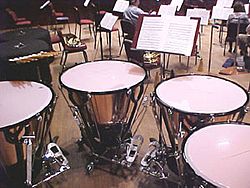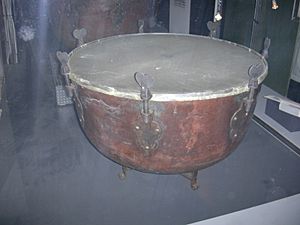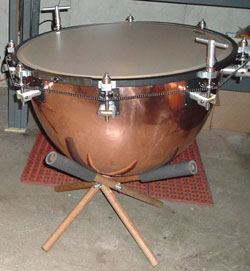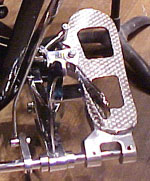Timpani facts for kids
 |
|
| Percussion instrument | |
|---|---|
| Other names | Kettle drum |
| Classification |
|
| Playing range | |
| Related instruments | |
|
|
Timpani are special drums that look like large bowls. They are often called kettle drums because of their shape. These bowls are usually made of copper. A skin-like material, called a "drumhead," is stretched tightly over the top. In the past, drumheads were made from animal skin, but today, most are made from a strong plastic.
The word Timpani comes from Italian. It is actually the plural form of timpano. However, in English, people usually just say "timpani" even when talking about one drum. A person who plays the timpani is called a "timpanist."
What makes timpani different from most other drums is that they can be tuned to play specific musical notes. This means they can play melodies, not just rhythms. When a timpani is tuned correctly, a timpanist might say it is "in voice." To play them, you hit the drumhead with special sticks called "timpani mallets." Unlike many other drums in orchestras or bands, timpani are tuned to specific notes. A timpanist usually plays a set of two, three, or four timpani at once.
Timpani were first used in official bands, like those for royalty. You can still see them in the bands of the Household Cavalry for Queen Elizabeth II in the United Kingdom. Here, large horses carry the "kettle drums." In the 1700s, timpani became popular in orchestral music. Famous composers like Handel and Beethoven wrote music that included timpani. Today, all large orchestras use timpani, and some popular music bands use them too.
Contents
How Timpani Are Made
The Drumhead
The drumhead of a timpani can be made from two main materials. Some are made from animal skin, like calfskin or goatskin. Others are made from thick plastic. Plastic drumheads are often used because they are strong, last a long time, and cost less than animal skin heads. However, many professional players prefer skin heads. They believe skin heads create a better sound when played. The drumhead is stretched over the timpani's bowl and held in place by screws. These screws are used for tuning the drum.
Tuning the Timpani
The screws that hold and tune the drumhead are called "tension rods." To tune the timpani, the player tightens or loosens these tension rods. If the rods are tightened, the timpani makes a higher sound. If they are loosened, the sound becomes lower. Most timpani have about seven tension rods.
Machine Timpani
Tuning a timpani by turning each tension rod separately can take a lot of time. Because of this, some timpani makers invented faster ways to change the drum's pitch.
Chain Timpani
In a chain timpani, all the tension rods are connected to a chain. This chain is linked to a lever. When the player moves the lever, it tightens or loosens all the screws at the same time. This quickly changes the drum's pitch.
Pedal Timpani
A pedal timpani uses a pedal to change its pitch. This is the most common type of timpani used today. A player can push the pedal down to make the timpani play higher notes. Letting the pedal come up allows it to play lower notes. There are three main types of pedal timpani:
- In a ratchet clutch system, the player pulls back a small lever called a clutch to let the pedal move. Once the pedal is in the right spot, they push the clutch forward with their foot to lock it.
- A balanced action system uses a spring connected to the pedal. This spring holds the pedal in place until the player moves it. Since there's no clutch holding it, some people call it a floating pedal.
- In a friction clutch system, a clutch holds the pedal in place. This clutch is attached to a pole. When the player releases the clutch, the pole moves up and down as the pedal is pushed.
Timpani Mallets
Timpani are played with special drumsticks called timpani mallets. A player uses two mallets at a time. Each mallet has two parts: the shaft and the head. The head is the round part that hits the timpani. The shaft is the part the timpanist holds.
A timpani mallet's head is usually a wooden sphere covered with felt or a thin cloth. The shaft is often made of wood, like hickory, cherry, or bamboo. Some shafts can also be made of metal, such as aluminum. Some mallets have a wooden head without felt. These are sometimes used in classical and baroque music.
In the early 20th century, some mallets had shafts made from whale bones and heads made from sponges.
Playing Techniques
With a pedal timpani, players can create different sound effects using the pedals. One special effect is called glissando. To make a glissando, the player presses the pedal while hitting the drum. This makes the pitch slide smoothly up or down. You can play a glissando at any volume. For example, the composer Alexander Rahbari used a glissando effect in his piece "Persian Mysticism Around G." The timpani player moves from a B-flat note up to a C, then rolls down to a G.
Related pages
Images for kids
See also
 In Spanish: Timbal de concierto para niños
In Spanish: Timbal de concierto para niños












